Overview
Job creation programs for communities play a crucial role in stimulating economic growth and enhancing the quality of life by creating employment opportunities and alleviating poverty. These initiatives are not merely beneficial; they are essential. Various types of programs and key players involved in this effort demonstrate that effective job creation significantly bolsters local economies. Moreover, it fosters social equity and strengthens community resilience.
The challenges faced by communities in job creation are multifaceted. Legal and regulatory hurdles often complicate land acquisition and program implementation. However, the impact of successful job creation initiatives is profound. They not only improve economic conditions but also contribute to a more equitable society.
In conclusion, it is imperative to recognize the value of these programs. The benefits extend beyond economic metrics; they enrich communities and empower individuals. Engaging with these initiatives is not just a choice; it is a necessity for sustainable growth and social progress.
Introduction
In an era where economic stability is crucial, job creation programs stand as a pivotal force for community development and prosperity. These initiatives not only provide essential employment opportunities but also play a significant role in alleviating poverty and revitalizing local economies. By focusing on marginalized groups and ensuring equitable access to job prospects, these programs cultivate a skilled workforce and advance social equity.
As communities endeavor to navigate the complexities of today’s labor market, it becomes increasingly vital to understand the various types of job creation programs, their funding sources, and the impact they exert on local economies. This exploration not only reveals the challenges these programs encounter but also showcases success stories that underscore their transformative potential.
The Importance of Job Creation Programs in Community Development
Job creation programs for communities are pivotal in stimulating economic expansion and enhancing the quality of life in local areas. These programs not only generate employment opportunities but also significantly reduce poverty levels and invigorate local economies. By focusing on job creation, these initiatives foster the growth of a skilled workforce, strengthen local resilience, and enhance social equity.
Targeting specific demographics, such as low-income individuals and marginalized groups, job creation programs ensure that the benefits of economic progress are equitably distributed. For instance, they have proven to enhance local quality of life by providing pathways to stable employment, which in turn fosters family sustainability and economic mobility.
Recent statistics reveal that communities with robust job development initiatives experience a notable increase in economic activity. Areas that have embraced job creation programs report higher participation and completion rates in workforce training, leading to improved employment outcomes and increased earnings for workers. Furthermore, the economic impact of anchor institutions has been examined in 524 regions across the U.S., underscoring the significant role these institutions play in local economies.
Case studies highlight the transformative effects of these programs. Sectoral partnerships formed by employers in specific industries have effectively collaborated with educational institutions and local organizations to train and place workers in high-quality positions. These collaborations not only meet industry demands but also bolster regional resilience, illustrating the interconnection between local development and job creation initiatives.
As Veronica Goodman states, "An essential goal of the federal workforce system should be to support good jobs that provide family-sustaining wages that grow the American middle class and lead to economic mobility."
In conclusion, job creation programs for communities are essential for promoting economic growth and enhancing the quality of life in neighborhoods. They serve as a foundation for building a skilled workforce, advancing social equity, and ensuring that the benefits of economic development are accessible to all segments of the population. A review of Comprehensive Economic Development Strategies (CEDS) with strong workforce development components can inspire further discussion on effective job generation strategies relevant to the energy and infrastructure sectors, aligning with the interests of Directors of Land Acquisition.
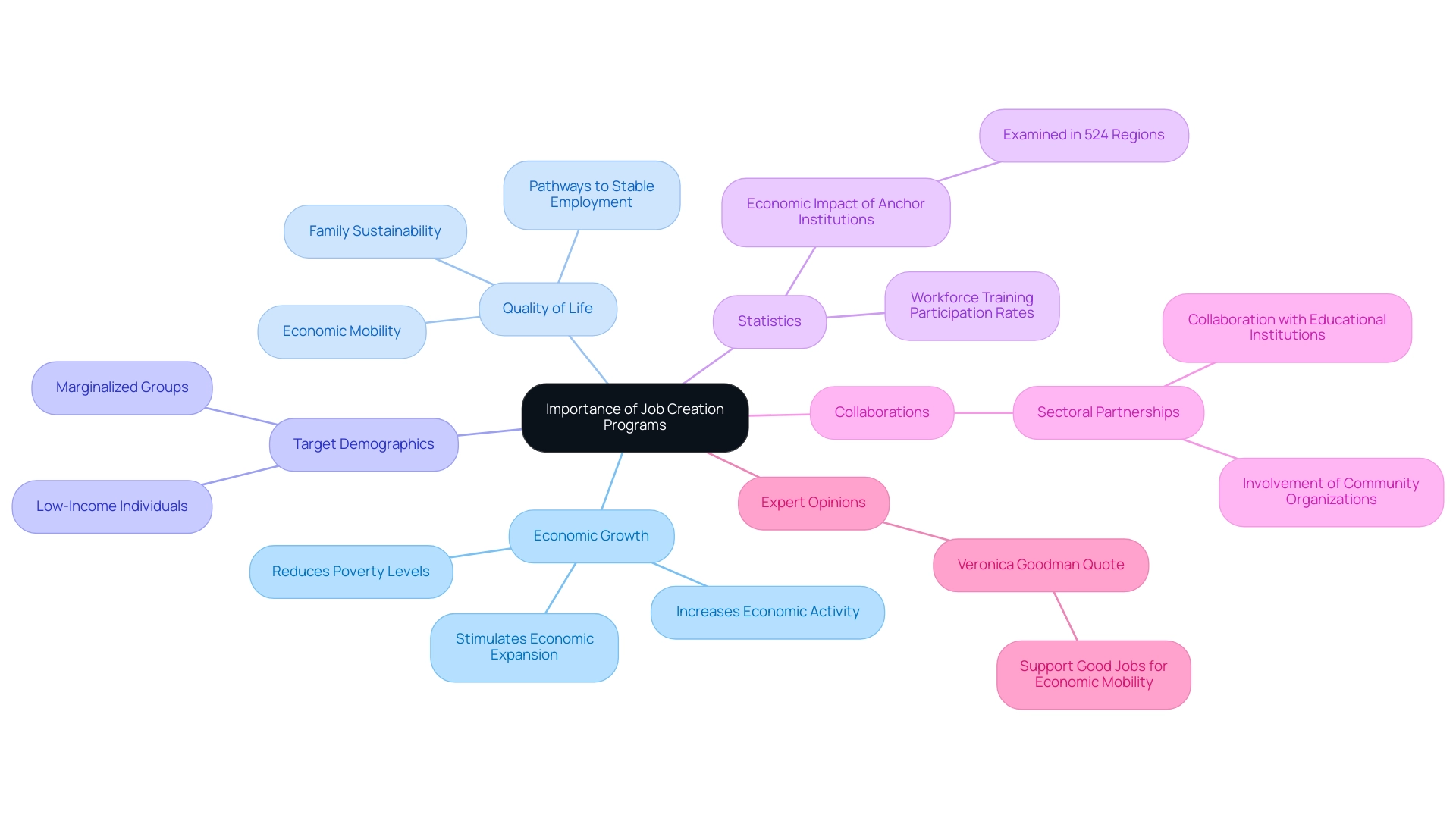
Types of Job Creation Programs: An Overview
Job creation programs are essential for addressing specific community needs and can be classified into several key categories:
- Direct Employment Programs: These initiatives involve government-funded projects that directly hire individuals, providing immediate job opportunities and contributing to local economies. Recent statistics indicate that such initiatives have effectively reduced unemployment rates, particularly in underserved areas.
- Tax Incentive Initiatives: These initiatives offer financial benefits to enterprises that generate employment in specified areas. By lowering operational costs, they encourage companies to expand their workforce, leading to significant economic growth. Data suggests that regions implementing tax incentives have experienced a notable increase in job creation, with some areas reporting up to a 30% rise in employment rates.
- Training and Development Programs: Aimed at equipping individuals with essential skills for available positions, these programs are crucial in closing the gap between workforce requirements and employee abilities. A strong emphasis on vocational training has been linked to improved job placement rates, particularly in high-demand sectors. According to SHRM, 92% of survey respondents indicated that training goals for organizations should reinforce a positive employee experience. Furthermore, investing in employee development not only benefits the workforce but also contributes positively to business outcomes, as highlighted in the case study "Driving Business Success."
- Community Job Creation Initiatives: These initiatives focus on revitalizing neighborhoods by creating jobs through infrastructure improvements and support for local businesses. By nurturing a flourishing local economy, they not only create jobs but also enhance the overall quality of life in the area.
Each category of initiative serves a distinct purpose and can be customized to meet the particular needs of a community, ultimately aiding in sustainable economic growth and employment opportunities. However, further research is necessary on the effects of vocational training initiatives in high-demand sectors beyond high-income nations, underscoring the significance of continuous assessment in employment enhancement efforts.
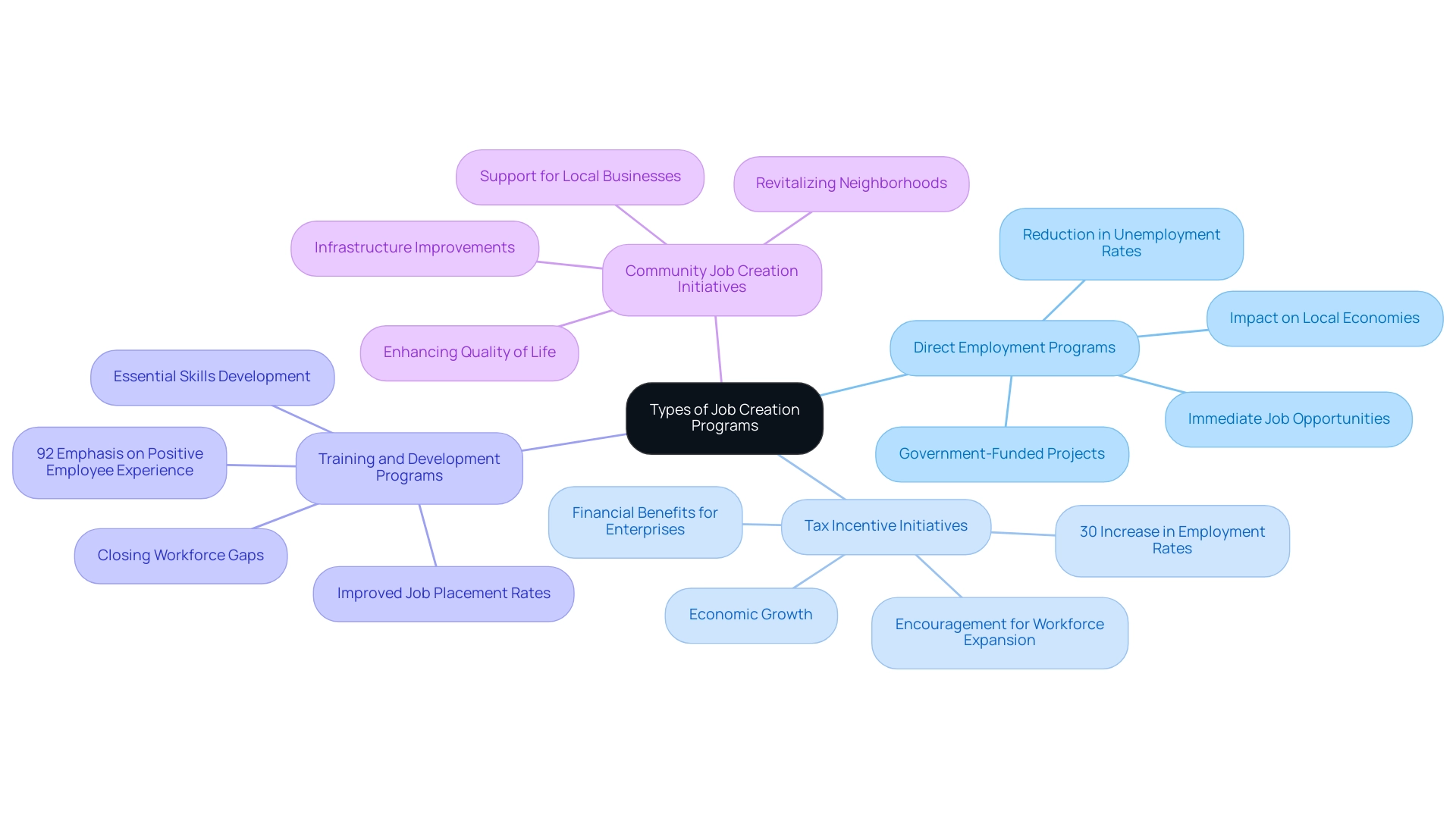
Key Players in Job Creation: Organizations and Their Roles
A variety of organizations play a crucial role in driving job creation, each contributing uniquely to the ecosystem:
- Government Agencies: These entities are instrumental in funding and overseeing job creation programs, ensuring compliance with regulatory standards. In 2025, increased federal funding for job training initiatives is anticipated, accompanied by a strong push for cost-effective solutions that can significantly impact local economies. As Harry J. Holzer, a Nonresident Senior Fellow at the Center for Economic Studies and Opportunity, states, "A strong case can be made that the U.S. needs to inject more federal funds into job training around the country and that WIOA is currently underfunded."
- Nonprofit Organizations: Often at the forefront of implementing targeted initiatives, nonprofits focus on assisting specific demographics, such as the unemployed or underemployed. Their efforts are bolstered by substantial funding, exemplified by the $19,653,200 awarded through Workforce Pathways for Youth grants, aimed at enhancing job readiness among young people. Furthermore, sectoral training initiatives that connect industry with workforce training providers can yield significant earnings increases for workers, with organizations like Per Scholas and Project Quest boosting earnings by $5,000 or more annually.
- Private Sector Companies: The private sector is vital not only in job creation but also in engaging in incentive programs that promote workforce development. Their participation is essential for fostering a robust job market.
Community Development Corporations (CDCs) are dedicated to revitalizing neighborhoods and promoting economic growth through job creation programs tailored to local communities. Their localized strategy ensures that job opportunities align with local needs.
Cooperation among these stakeholders is essential for the success of employment initiatives. For instance, the Select Talent USA initiative, launched in May 2023, exemplifies how partnerships between government agencies and private entities can effectively tackle workforce recruitment and retention challenges, particularly by expanding apprenticeship opportunities in collaboration with international markets.
As the landscape of employment development evolves, the interplay between these organizations will be vital in shaping effective strategies that meet the demands of the workforce in 2025, particularly concerning community engagement and outreach strategies for gas and oil projects.
Eligibility Requirements for Job Creation Programs
The eligibility criteria for job creation programs for communities are critical to understanding how these initiatives operate. These criteria can vary significantly based on the programs' objectives and funding sources. Key criteria typically include:
- Income Level: Many initiatives are specifically designed to assist low-income individuals or families, aiming to uplift those facing economic hardships. For instance, these programs often focus on individuals earning below a specified threshold, ensuring that assistance effectively reaches those who need it most.
- Geographic Location: Numerous efforts target specific areas or demographics experiencing economic difficulties. This geographic focus is essential for addressing localized needs and fostering community development.
- Employment Status: Many initiatives prioritize individuals who are currently unemployed or underemployed, recognizing the necessity of providing opportunities to those struggling to secure stable employment.
- Business Type: In the context of tax incentive initiatives, eligibility may depend on the industry or size of the business. For example, small enterprises within targeted sectors may receive preferential treatment to stimulate growth and employment in those areas.
Understanding these eligibility criteria is crucial for maximizing participation in job creation programs for communities. Notably, Congress funds 220,000 learners annually at $2,000 per learner, underscoring the financial commitment to workforce development. Furthermore, the overall economy is projected to contribute approximately 4.7 million positions during the 2022–32 decade, highlighting the vital role of job creation programs in meeting employment demands.
However, challenges persist. Data on WIOA-funded training initiatives is often incomplete, with over 75% of initiatives lacking essential enrollment and performance information. This limitation complicates the assessment of effectiveness and emphasizes the need for comprehensive data. Additionally, the U.S. workforce development system is currently underfunded, making it imperative to ensure that employment initiatives effectively reach their intended beneficiaries, especially given these funding challenges.
As the landscape evolves, particularly in 2025, staying informed about changes in eligibility criteria and their implications for various communities is essential.
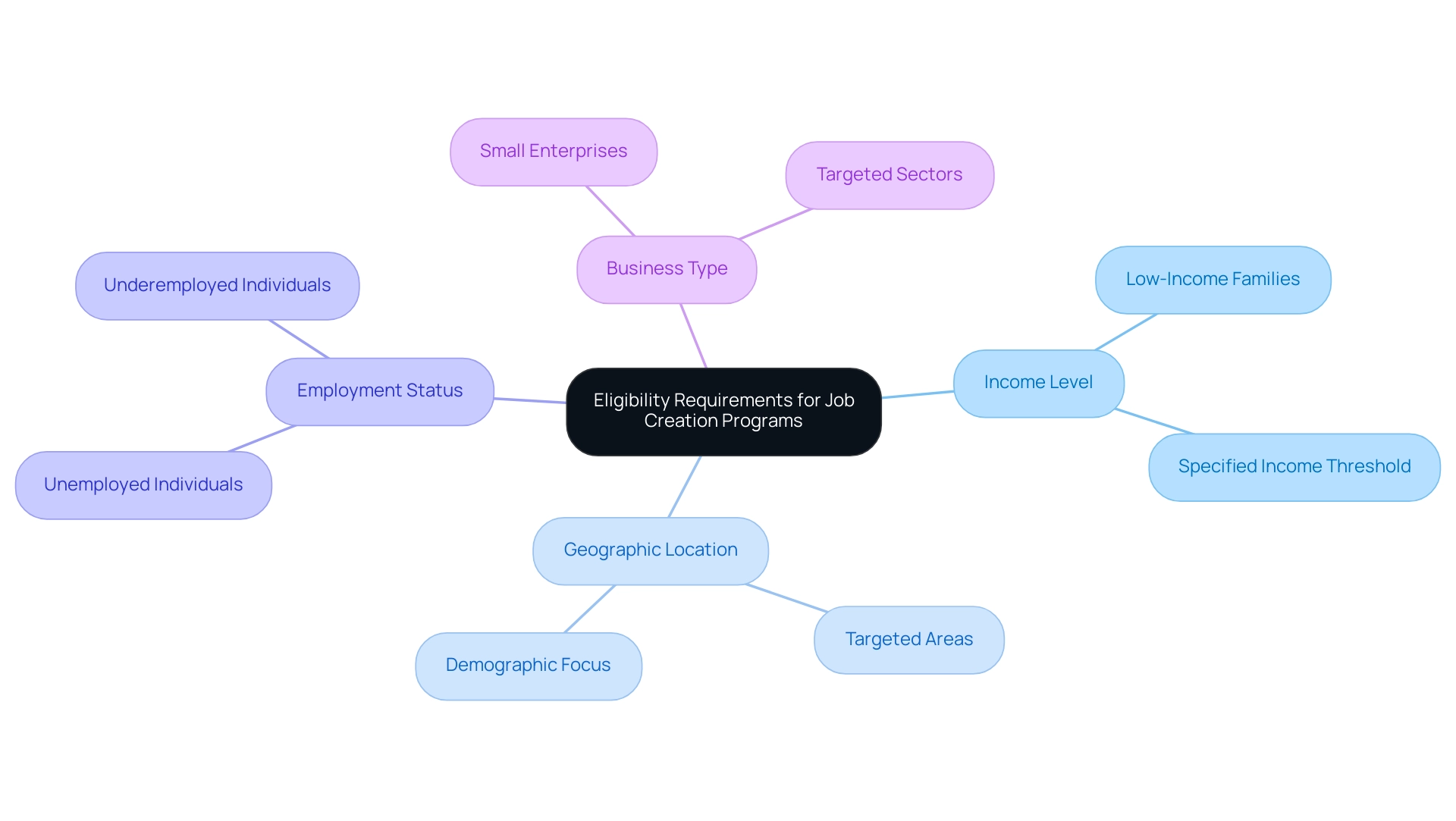
Funding Sources for Job Creation Programs
Job creation programs are supported by a diverse array of funding sources, each playing a critical role in fostering economic development.
- Federal Grants: Numerous programs benefit from federal funding aimed at stimulating economic growth. These grants are frequently distributed through different agencies focused on job establishment and workforce development, providing essential financial assistance for job creation programs that align with national economic objectives.
- State and Local Government Funding: State and local governments frequently allocate portions of their budgets to support job creation programs for communities. This funding is essential for local projects that address specific needs and can significantly influence regional employment rates.
- Private Sector Investments: Corporations often contribute to job development programs as part of their corporate social responsibility strategies. These investments not only improve their relationships with the public but also assist in developing a skilled workforce that can benefit their operations in the long run.
- Nonprofit Organizations: Various nonprofit entities provide grants or funding for targeted job development projects. These organizations often concentrate on underserved communities, ensuring that employment initiatives reach those who require them the most.
Understanding these funding sources is essential for developing sustainable job creation programs. For instance, establishing a comprehensive career navigation system could leverage federal grants to provide real-time labor market information, thereby enhancing the effectiveness of job development programs. As Susannah Rodrigue, Senior Manager for Policy at JFF, stated, "Now is the time to transform this country’s workforce development system."
This call to action is particularly relevant given the 4.7 million young adults aged 16 to 24 who are currently neither working nor in school. By tapping into these funding avenues, stakeholders can develop robust job creation programs that not only address immediate employment needs but also foster long-term economic resilience, particularly in the context of land acquisition strategies for energy and infrastructure projects. Furthermore, the EDA's innovative metrics can assess the impact of these non-infrastructure investments, ensuring that job initiatives are effectively aligned with community and economic development goals.
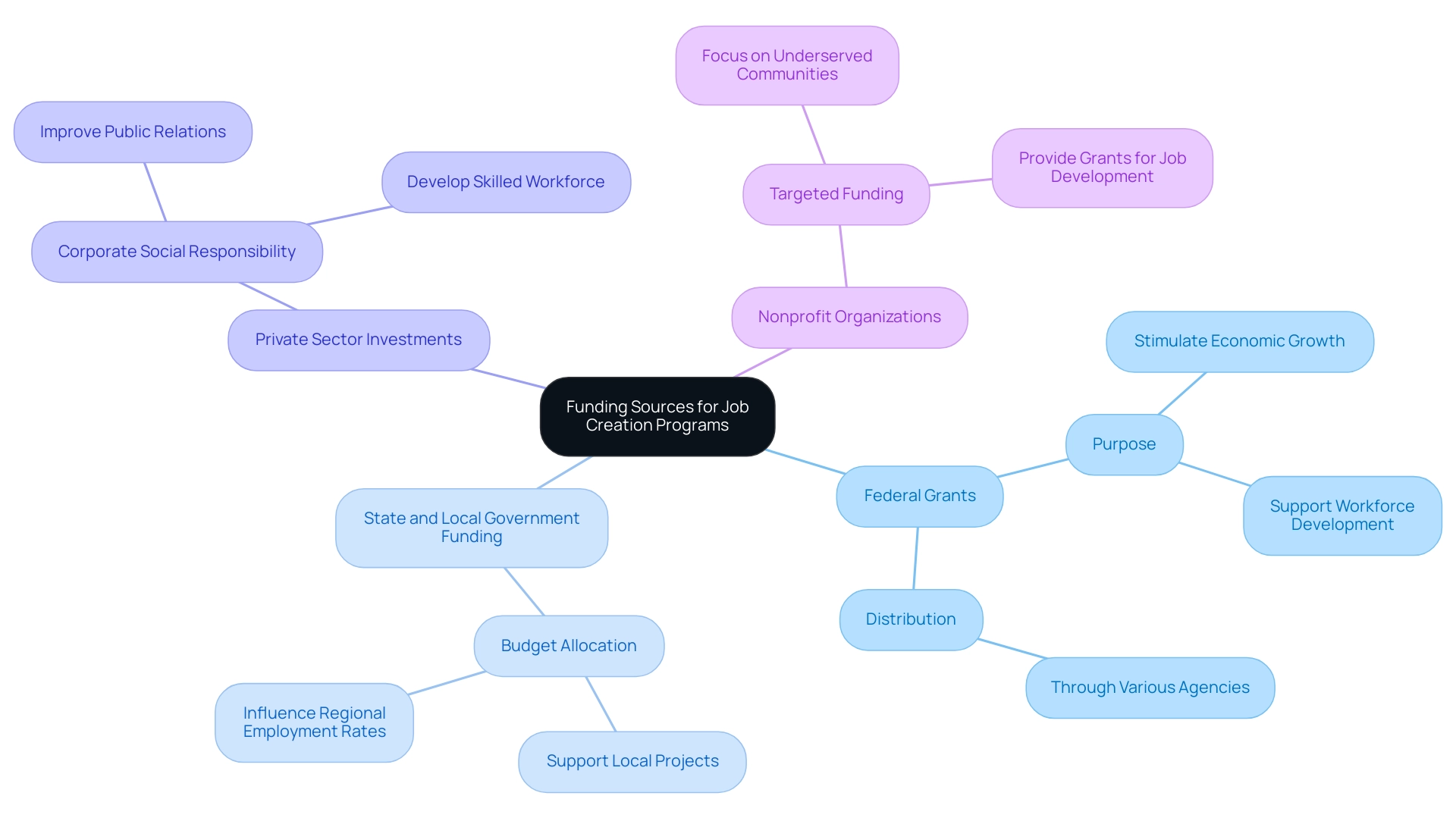
Impact of Job Creation Programs on Local Economies
Job development initiatives play a crucial role in enhancing local economies through multiple avenues:
- Increased Employment Rates: These initiatives are vital in decreasing both unemployment and underemployment. Successful job development programs have been linked to a significant rise in employment rates, contributing to a healthier labor market. As of June 2024, the transportation and warehousing sector alone reported an employment level of 6.6 million, highlighting the importance of workforce development in specific industries.
- Economic Growth: The creation of jobs directly correlates with increased consumer spending, which in turn invigorates local businesses. As employment opportunities expand, communities witness a surge in economic activity, fostering a robust local economy. The total economy is projected to add approximately 4.7 million jobs during the 2022–32 decade, underscoring the broader context of employment opportunities and anticipated growth.
- Community Revitalization: Job opportunities often lead to enhanced infrastructure and improved public services, elevating the overall quality of life for residents. This revitalization can attract further investment and development, creating a positive feedback loop.
- Social Stability: Access to employment opportunities is essential for promoting social cohesion and reducing crime rates. Communities with higher employment levels typically experience lower incidences of crime, contributing to a safer environment for all residents. Moreover, real average weekly earnings increased by 0.6% from February 2024 to February 2025, emphasizing the economic benefits of job initiatives on individual earnings.
The benefits of job initiatives extend well beyond personal employment, fostering extensive economic growth and nurturing a strong community fabric. As of early 2025, the ongoing focus on job development remains critical, particularly in light of fluctuating interest rates and evolving labor market conditions. The Federal Reserve's recent interest rate policy, which included a cut of 1.00% between September and December 2024, reflects ongoing concerns about labor market stability and potential inflationary pressures.
This context underscores the importance of strategic initiatives in sustaining economic growth, especially as interest rates present both risks and opportunities for employment initiatives.
Challenges in Implementing Job Creation Programs
Establishing job creation programs for communities presents numerous obstacles that can impede their efficiency and longevity. These key obstacles include:
- Funding Limitations: Securing sufficient funding remains a critical barrier. Many job creation programs for communities encounter challenges due to inadequate financial resources, hindering progress and restricting the extent of efforts. Recent statistics reveal that funding limitations are a primary concern for over 60% of directors, underscoring the urgent need for increased investment in these initiatives. Notably, a funding request of $812 million has been proposed to support the Bureau of Labor Statistics (BLS) in modernizing the Current Population Survey (CPS), emphasizing the importance of adequate funding in job creation programs for communities.
- Bureaucratic Red Tape: The complexity of navigating government regulations can significantly delay project implementation. Bureaucratic hurdles often lead to inefficiencies, with studies indicating that initiatives may require approximately 2 1/2 to 3 follow-up contacts after the initial request to elicit a response from relevant authorities. Such delays can frustrate stakeholders and diminish momentum.
Gaining backing from local enterprises and residents is essential for the success of job creation programs for communities. However, fostering this engagement can be challenging, particularly in communities with diverse interests and priorities. Effective outreach strategies are crucial to ensure that all voices are heard and considered in the planning process. Advancing a social compact that promotes sustainable and equitable growth is vital in this context.
- Measuring Impact: Demonstrating the effectiveness of employment initiatives poses another significant challenge. Short-term metrics may not adequately capture the long-term benefits of these initiatives, complicating the justification for continued funding and support. Experts emphasize the need for robust evaluation frameworks that can provide clear evidence of impact over time. As Haworth pointed out, "Individuals facing deportation often arrived in America for employment, so if they depart, other workers will need to fill those positions," emphasizing the human aspect of job availability.
Addressing these challenges necessitates strategic planning and collaboration among all stakeholders involved in job creation programs for communities. By encouraging transparent dialogue and utilizing common resources, groups can establish more robust employment initiatives that effectively address local requirements and economic conditions. The modernization of the CPS serves as a case study that highlights the importance of dependable data in shaping effective job development policies and initiatives.
Success Stories: Case Studies of Effective Job Creation Programs
Multiple successful employment initiatives illustrate efficient approaches for promoting economic expansion and local development. Among these, the New Markets Tax Credit Program stands out, having generated and preserved over 888,200 jobs from 2003 to 2015 by encouraging investments in low-income areas. This initiative not only stimulates economic activity but also revitalizes communities that have historically faced economic challenges.
The continuous efforts of the NMTC Coalition since 2005 have been crucial in providing billions of dollars to businesses, further highlighting the initiative's effectiveness.
The Community Development Block Grant Program plays a critical role in supporting job growth and retention efforts, particularly for low- and moderate-income individuals. By supplying essential funding, this initiative allows local authorities to execute projects that directly assist their residents, improving job prospects and economic stability.
Additionally, the Workforce Innovation and Opportunity Act (WIOA) significantly contributes to local employment rates by funding job training and employment services. This initiative equips individuals with the skills necessary to thrive in the job market, thereby fostering a more skilled workforce and reducing unemployment.
These case studies highlight the diverse methodologies employed in job creation programs for communities and underscore the positive outcomes that can arise from well-executed initiatives. For instance, the construction of a 20,000 square-foot facility for the YMCA in Pueblo, Colorado, was funded through a $9.2 million allocation in NMTCs. This project not only created 65 construction jobs but also generated over 140 permanent positions, offering essential services to the public.
Cinnaire emphasizes the importance of such initiatives, stating, "We use each allocation of NMTCs to support large-scale financing for a range of community facilities that support our belief that all people deserve the opportunities provided by living in healthy communities." The effect of these initiatives is further demonstrated by the ongoing efforts of organizations like Romark, which recently received a $1.2 million employment development incentive from the Puerto Rico Industrial Development Company, showcasing the tangible benefits of strategic investments in job creation programs for communities.
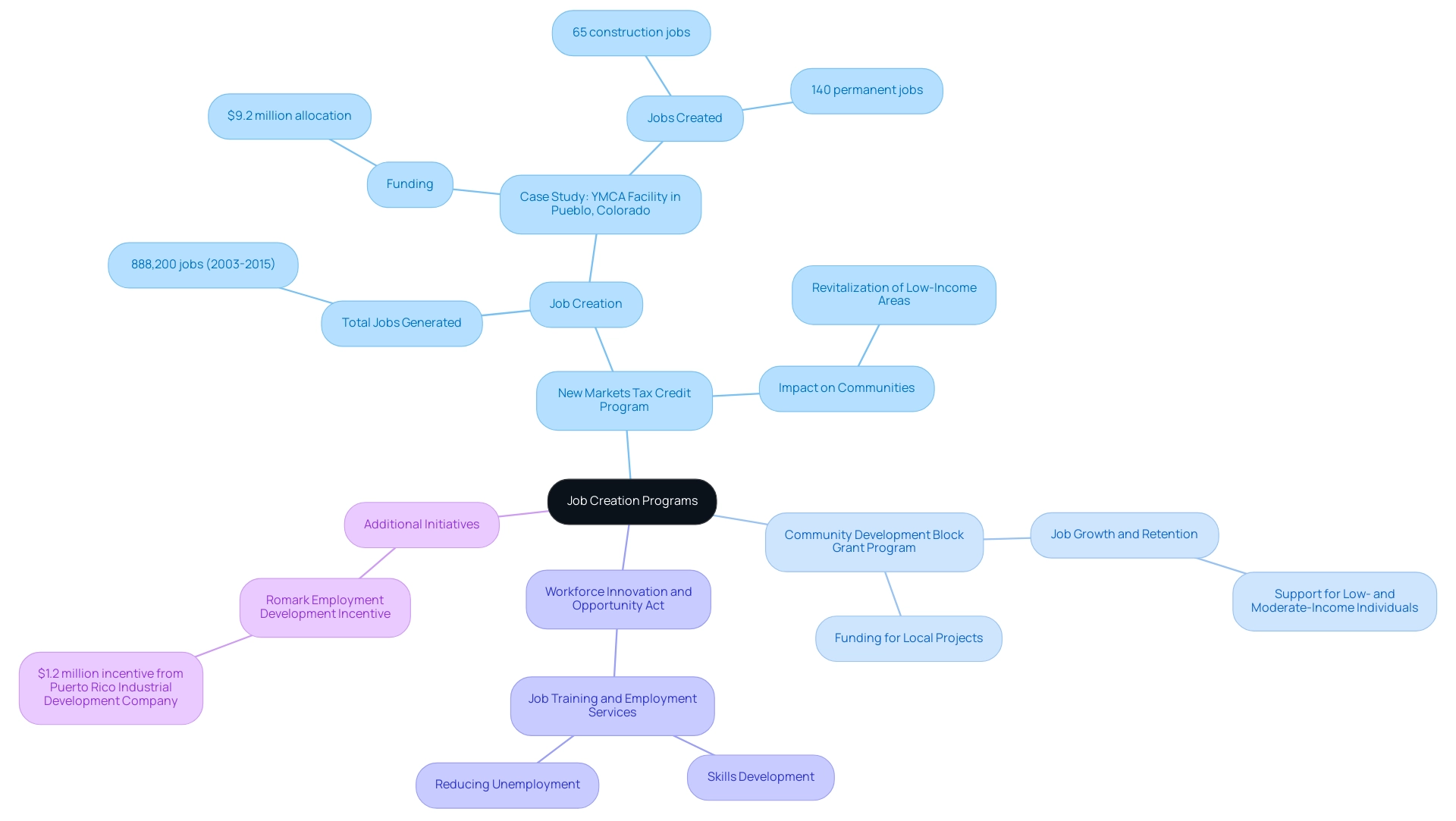
The Future of Job Creation Programs: Trends and Innovations
The future of employment initiatives is set to be shaped by several key trends reflecting the evolving economic landscape.
- Increased Use of Technology: Innovations such as artificial intelligence and data analytics are poised to significantly enhance the efficiency and effectiveness of job development initiatives. These technologies streamline processes, enabling better targeting of resources and improved outcomes for participants. However, organizations must navigate challenges related to shadow IT, as outlined in a recent guide that evaluates tools and assesses risks associated with unregulated technology use.
- Focus on Green Jobs: Sustainability is becoming central for many communities, prompting job creation programs to prioritize green industries. This shift not only addresses environmental concerns but also opens new avenues for employment in sectors like renewable energy, sustainable agriculture, and conservation.
- Emphasis on Skills Training: As the job market evolves, there will be a heightened focus on equipping workers with the necessary skills for emerging roles. Bessen notes that while the demand for college graduates has grown, it primarily stems from their ability to learn new, unstandardized skills on the job. Programs will likely incorporate tailored training initiatives that align with industry demands, ensuring participants are prepared for the future workforce. This urgency is underscored by Frey and Osborne's (2017) prediction that 47% of U.S. workers are at risk of job automation, highlighting the critical need for effective skills training.
- Collaboration Across Sectors: Effective employment development necessitates robust partnerships among government entities, the private sector, and nonprofit organizations. Collaborative efforts are essential in addressing the multifaceted challenges of job development, particularly through community job creation programs that leverage diverse resources and expertise to foster sustainable employment opportunities. Furthermore, with 45% of technology leaders raising salaries to attract top candidates amid hiring challenges, the competitive landscape for job initiatives in technology sectors is becoming increasingly pronounced.
These trends indicate a dynamic and promising future for job programs, characterized by innovation and growth potential, particularly in technology and green employment. The economic impact of automation further illustrates the necessity for adaptive job creation strategies, as it reshapes labor market dynamics and influences the demand for skilled workers.
Conclusion
Job creation programs stand as essential drivers of economic growth and community development, addressing unemployment and poverty through a multifaceted approach. These initiatives generate employment opportunities that not only enhance individual quality of life but also invigorate local economies. Various program types—ranging from direct employment initiatives to tax incentives and vocational training—illustrate the diverse strategies employed to meet specific community needs. Each program plays a unique role in fostering a skilled workforce and promoting social equity, ensuring equitable distribution of economic benefits.
The collaborative efforts of government agencies, nonprofit organizations, private sector companies, and community development corporations are critical for the success of job creation initiatives. By pooling resources and expertise, these stakeholders can create robust programs that effectively tackle local challenges. However, they must navigate obstacles such as funding limitations, bureaucratic hurdles, and the need for stakeholder engagement to enhance program effectiveness. Moreover, the significance of comprehensive data and evaluation frameworks cannot be overstated, as these elements are vital for measuring impact and justifying continued investment in these initiatives.
Looking ahead, the future of job creation programs is promising. Trends indicate a shift towards technology integration, green jobs, and enhanced skills training. As communities adapt to the evolving labor market, a focus on sustainable employment and cross-sector collaboration will be paramount. By embracing innovation and addressing the unique needs of their populations, job creation programs can continue to transform local economies and uplift marginalized communities, ultimately contributing to a more equitable and prosperous society.
Frequently Asked Questions
What are job creation programs and why are they important for communities?
Job creation programs are initiatives designed to stimulate economic expansion and enhance local quality of life by generating employment opportunities. They play a crucial role in reducing poverty levels, fostering a skilled workforce, strengthening local resilience, and promoting social equity.
Who do job creation programs typically target?
These programs often focus on specific demographics, such as low-income individuals and marginalized groups, to ensure that the benefits of economic progress are distributed equitably.
What impact do job creation programs have on local economies?
Communities with robust job development initiatives experience increased economic activity, higher workforce training participation rates, improved employment outcomes, and increased earnings for workers.
What are some key categories of job creation initiatives?
Key categories include: Direct Employment Programs (government-funded projects that directly hire individuals), Tax Incentive Initiatives (financial benefits for companies that create jobs in specified areas), Training and Development Programs (aimed at equipping individuals with essential skills for available positions), and Community Job Creation Initiatives (efforts that revitalize neighborhoods through infrastructure improvements and support for local businesses).
How do organizations contribute to job creation?
Various organizations contribute uniquely: Government Agencies fund and oversee job creation programs; Nonprofit Organizations implement targeted initiatives for specific demographics; Private Sector Companies engage in job creation and workforce development incentive programs; Community Development Corporations (CDCs) focus on local strategies for job creation aligned with community needs.
What is the significance of collaboration among different organizations in job creation?
Cooperation among government agencies, nonprofits, and private sector companies is essential for the success of employment initiatives. Collaborative efforts can effectively address workforce recruitment and retention challenges.
What future trends are anticipated in job creation and workforce development?
Increased federal funding for job training initiatives is expected in 2025, alongside a strong emphasis on cost-effective solutions to impact local economies positively. The interplay between organizations will be vital in shaping effective strategies to meet workforce demands.
List of Sources
- The Importance of Job Creation Programs in Community Development
- Workforce Development: Reimagining and Modernizing How To Connect Workers With Good Jobs (https://americanprogress.org/article/a-progressive-vision-for-education-in-the-21st-century/workforce-development-reimagining-and-modernizing-how-to-connect-workers-with-good-jobs)
- Community Development Data (https://philadelphiafed.org/surveys-and-data/community-development-data)
- Workforce Development | U.S. Economic Development Administration (https://eda.gov/resources/comprehensive-economic-development-strategy/content/workforce-development)
- Types of Job Creation Programs: An Overview
- Navigating Public Job Training (https://pw.hks.harvard.edu/post/publicjobtraining)
- blog.clearcompany.com (https://blog.clearcompany.com/27-surprising-employee-development-statistics-you-dont-know)
- Vocational and skills training programs to improve labor market outcomes (https://povertyactionlab.org/policy-insight/vocational-and-skills-training-programs-improve-labor-market-outcomes)
- Employee Training Statistics, Trends, and Data in 2025 | Devlin Peck (https://devlinpeck.com/content/employee-training-statistics)
- Key Players in Job Creation: Organizations and Their Roles
- Should the federal government spend more on workforce development? (https://brookings.edu/articles/should-the-federal-government-spend-more-on-workforce-development)
- Biden-Harris administration awards $71M in grants to improve job quality, prepare workers, expand access to good jobs in critical sectors (https://dol.gov/newsroom/releases/eta/eta20240925)
- Investing in America, Investing in Americans Workforce Development Programs at the U.S. Department of Commerce (https://commerce.gov/news/fact-sheets/2024/05/investing-america-investing-americans-workforce-development-programs-us)
- Eligibility Requirements for Job Creation Programs
- Navigating Public Job Training (https://pw.hks.harvard.edu/post/publicjobtraining)
- bls.gov (https://bls.gov/emp)
- Funding Sources for Job Creation Programs
- Recommendations for a Fully Funded and Transformed Workforce Development System (https://jff.org/idea/recommendations-for-a-fully-funded-and-transformed-workforce-development-system)
- EDA Performance Measurement and Program Evaluation | U.S. Economic Development Administration (https://eda.gov/archives/2021/performance)
- Impact of Job Creation Programs on Local Economies
- bls.gov (https://bls.gov/emp)
- The Effect of the Job Market on the Economy | U.S. Bank (https://usbank.com/investing/financial-perspectives/market-news/effect-of-job-market-on-the-economy.html)
- Current Employment Statistics - CES (National) (https://bls.gov/ces)
- Challenges in Implementing Job Creation Programs
- The Bureau of Labor Statistics Must Be Adequately Funded To Preserve Economic Data and Improve Americans’ Financial Security (https://americanprogress.org/article/the-bureau-of-labor-statistics-must-be-adequately-funded-to-preserve-economic-data-and-improve-americans-financial-security)
- The Effect of the Job Market on the Economy | U.S. Bank (https://usbank.com/investing/financial-perspectives/market-news/effect-of-job-market-on-the-economy.html)
- Success Stories: Case Studies of Effective Job Creation Programs
- New Markets Tax Credit Success Stories - TruFund (https://trufund.org/products-services/new-markets-tax-credits-empowerment-reinvest-fund-llc/new-markets-tax-credit-success-stories)
- NMTC Reports and Research (https://novoco.com/resource-centers/new-markets-tax-credits/nmtc-reports-and-research)
- New Markets Tax Credit Coalition Releases Report Highlighting NMTC Success Stories & State Statistics - Cinnaire - Advancing Communities (https://cinnaire.com/new-markets-tax-credit-coalition-releases-report-highlighting-nmtc-success-stories-state-statistics)
- The Future of Job Creation Programs: Trends and Innovations
- Assessing the Impact of New Technologies on the Labor Market: Key Constructs, Gaps, and Data Collection Strategies for the Bureau of Labor Statistics (https://bls.gov/bls/congressional-reports/assessing-the-impact-of-new-technologies-on-the-labor-market.htm)
- 2025 tech job market statistics and outlook (https://techtarget.com/whatis/feature/Tech-job-market-statistics-and-outlook)
- 20 Technology in the Workplace Statistics, Trends, and Predictions (https://auvik.com/franklyit/blog/technology-in-the-workplace-statistics)




